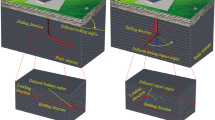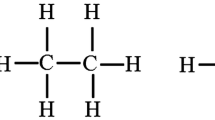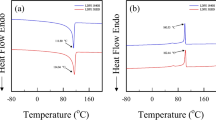Abstract
For two commonly used modified emulsified asphalts, styrene butadiene rubber (SBR) and styrene butadiene styrene (SBS), direct heating and low-temperature evaporation methods were respectively applied to obtain the asphaltic residues. Nanotechnology provides a great solution to road construction issues. However, the use of nanoparticles increases the durability of asphalts and enhances the performance of bitumen. Dynamic shear rheometer (DSR) was employed for temperature scanning test and multiple stress creep recovery (MSCR) test of the asphaltic residues. In this paper, the changes in the rheological properties of the asphaltic residues were compared and analyzed. The influence of evaporation temperature on the rheological properties of modified emulsified asphaltic residues obtained by evaporation was discussed. Evaporation tests showed that the higher the evaporation temperature, the larger the mass reduction of residues at the early stage and the shorter the time needed to reach stabilization. The solid contents of modified emulsified asphaltic residues obtained under different evaporation temperatures also differed. The solid content of asphaltic residues obtained under the evaporation temperature of 60 °C was closest to that by the low-temperature evaporation method. This indicated influence of the evaporation temperature on the solid content of asphaltic residues. Based on the results of temperature scanning test and MSCR test, there was a significant difference in the rheological properties of the asphaltic residues obtained by direct heating and low-temperature evaporation methods. The anti-deformation capacity under high temperature in asphaltic residues obtained at different evaporation temperatures varied more greatly. For SBS-modified emulsified asphalt, the rutting resistance under high temperature in residues obtained by the low-temperature evaporation method was better; however, the opposite was true for the SBR-modified emulsified asphalt. This indicated that the high-temperature evaporation method may overestimate the high-temperature properties of SBR-modified emulsified asphaltic residues and underestimate the high-temperature properties of SBS-modified emulsified asphaltic residues. For the emulsified asphalt samples, the appropriate method to obtain asphaltic residues that are closest to the actual road conditions should be optimized depending on the specific purposes.















Similar content being viewed by others
Data availability
All data generated or analyzed during this study are included in this article.
Change history
14 August 2021
A Correction to this paper has been published: https://doi.org/10.1007/s11051-021-05234-0
References
AASHTO PP72–11 Recovering Residue from Emulsified Asphalt Using Low-Temperature Evaporative Techniques [S]
ASTM D244 D6997–12 (2012) Standard test method for distillation of emulsified asphalt [S]. West Conshohocken
ASTM D244 D7403–09 (2009) standard test method for determination of residue of emulsified asphalt by low temperature vacuum distillation [S]. West Conshohocken
ASTM D7497–09, (2009) Standard Practice for Recovering Residue from Emulsified Asphalt Using Low Temperature Evaporative Technique[S]. West Conshohocken
ASTMD244 D6934–08 (2008) standard test method for residue by evaporation of emulsified asphalt [S]. West Conshohocken
Chang YY, Pei JJ, Yao DH (2004) Comparison study on two test methods for determination of residue by evaporation in emulsified asphalt [J]. Petroleum Asphalt 06:49–52
EN 13704–02, (2002) Petroleum products - Bitumen and bituminous binders - Recovery of binder from bitumen emulsions by evaporation [S]. British Standards Institution
Huang W, Tang N (2015) Characterizing SBS modified asphalt with sulfur using multiple stress creep recovery test. Constr Build Mater 93:514–521
JTG E20 (2011) Standard Test Methods of Bitumen and Bituminous Mixtures for Highway Engineering [S]
Kong XM, Liu GX (2004) Analysis of the methods to obtain emulsified asphaltic residues [J]. Petroleum Asphalt 06:19–22
Li CH, Zhang XL (2008) Content of emulsified asphaltic residues obtained by evaporation method [J]. Petroleum Asphalt 03:49–50
Qin YC, Xu J, Huang SC, Li FP (2004) Study on the experimental method for emulsified asphalt and relevant contents [J]. Petroleum Asphalt 06:27–31
Tang N, Huang W, Zheng M, Hu J (2017) Investigation of Gilsonite-, polyphosphoric acid- and styrene-butadiene-styrene-modified asphalt binder using the multiple stress creep and recovery test. Road Mater Pavement Design 18(5):1084–1097
Tian SB, Niu XW (2014) Analysis of methods to obtain emulsified asphaltic residues [J]. Shanghai Highways 01:61–63
Wang WF, Zhu FW, Niu XW, Wu DS (2018) Comparison of evaluation indicators and experimental methods for emulsified asphalt in China, US and Europe [J]. Petroleum Asphalt 32(03):7–11+16
Yang X, You Z (2015) High temperature performance evaluation of bio-oil modified asphalt binders using the DSR and MSCR tests. Constr Build Mater 76:380–387
Zhang DH, Li JY, Zhang XX (2009) Influence factors of determination results of three major indicators of asphalt [J]. Petroleum Asphalt 23(06):57–60
Zhang L, Xing C, Gao F, Li T, Tan Y (2016) Using DSR and MSCR tests to characterize high temperature performance of different rubber modified asphalt. Constr Build Mater 127:466–474
Funding
This research was supported by National College Students’ innovation and entrepreneurship training program (20181049702007) and Undergraduate Project of Independent Innovation Research Fund (2018-JT-B1-05) of Wuhan University of Technology.
Author information
Authors and Affiliations
Corresponding author
Ethics declarations
Conflict of interest
The authors declare that they have no conflict of interest.
Additional information
Publisher’s note
Springer Nature remains neutral with regard to jurisdictional claims in published maps and institutional affiliations.
This article is part of the topical collection: Role of Nanotechnology and Internet of Things in Healthcare
This article has been retracted. Please see the retraction notice for more detail: https://doi.org/10.1007/s11051-021-05234-0
About this article
Cite this article
Chen, X., Cheng, G. & Xu, W. RETRACTED ARTICLE: Influence of evaporation temperature on the rheological properties of modified emulsified asphaltic residues. J Nanopart Res 22, 228 (2020). https://doi.org/10.1007/s11051-020-04952-1
Received:
Accepted:
Published:
DOI: https://doi.org/10.1007/s11051-020-04952-1




